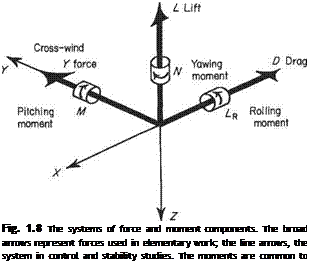Basic aerodynamics
1.5.1 Aerodynamic force and moment
Air flowing past an aeroplane, or any other body, must be diverted from its original path, and such deflections lead to changes in the speed of the air. Bernoulli’s equation shows that the pressure exerted by the air on the aeroplane is altered from that of the undisturbed stream. Also the viscosity of the air leads to the existence of frictional forces tending to resist its flow. As a result of these processes, the aeroplane experiences a resultant aerodynamic force and moment. It is conventional and convenient to separate this aerodynamic force and moment into three components each, as follows.
Lift, L[-Z)
This is the component of force acting upwards, perpendicular to the direction of flight or of the undisturbed stream. The word ‘upwards’ is used in the same sense that the pilot’s head is above his feet. Figure 1.7 illustrates the meaning in various attitudes of flight. The arrow V represents the direction of flight, the arrow L represents the lift acting upwards and the arrow W the weight of the aircraft, and shows the downward vertical. Comparison of (a) and (c) shows that this upwards is not Fixed relative to the aircraft, while (a), (b), and (d) show that the meaning is not fixed relative to the earth. As a general rule, if it is remembered that the lift is always
|
|
||
|
|||


Fig. 1.7 The direction of the lift force
a component perpendicular to the flight direction, the exact direction in which the lift acts will be obvious, particularly after reference to Fig. 1.7. This may not apply to certain guided missiles that have no obvious top or bottom, and the exact meaning of ‘up’ must then be defined with care.
Drag, D(-X)
This is the component of force acting in the opposite direction to the line of flight, or in the same direction as the motion of the undisturbed stream. It is the force that resists the motion of the aircraft. There is no ambiguity regarding its direction or sense.
Cross-wind force, Y
This is the component of force mutually perpendicular to the lift and the drag, i. e. in a spanwise direction. It is reckoned positive when acting towards the starboard (right-hand to the pilot) wing-tip.
Pitching moment, M
This is the moment acting in the plane containing the lift and the drag, i. e. in the vertical plane when the aircraft is flying horizontally. It is positive when it tends to increase the incidence, or raise the nose of the aircraft upwards (using this word in the sense discussed earlier).
Rolling moment, LR
This is the moment tending to make the aircraft roll about the flight direction, i. e. tending to depress one wing-tip and to raise the other. It is positive when it tends to depress the starboard wing-tip.
Yawing moment, N
This is the moment that tends to rotate the aircraft about the lift direction, i. e. to swing the nose to one side or the other of the flight direction. It is positive when it swings, or tends to swing, the nose to the right (starboard).
 |
The relation between these components is shown in Fig. 1.8. In each case the arrow shows the direction of the positive force or moment. All three forces are mutually perpendicular, and each moment acts about the line of one of the forces.
The system of forces and moments described above is conventionally used for performance analysis and other simple problems. For aircraft stability and control studies, however, it is more convenient to use a slightly different system of forces.












